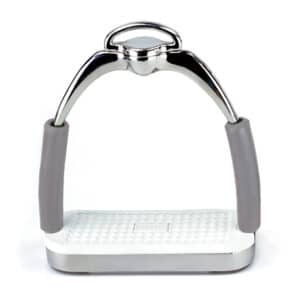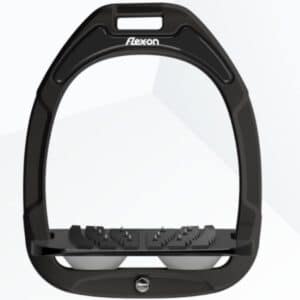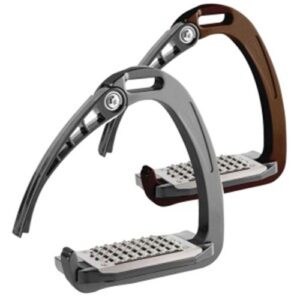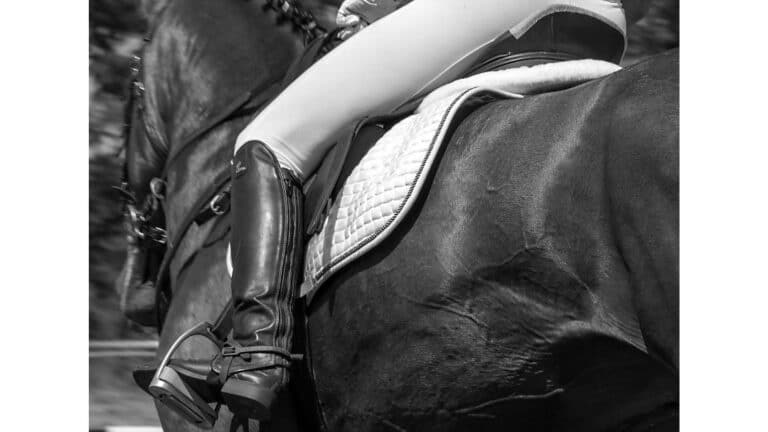15 to 20 years ago, the humble stirrup irons were a fairly inconsequential piece of tack, usually only noticed by their absence when your coach made you ride without them! However, like much of our riding gear, they have since been developed into technical pieces of equipment with an eye-watering array of options.
It turns out this isn’t the first time stirrups have undergone an evolution, with some saying their role in history was as important as the wheel or printing press. When the early L-shaped stirrups evolved into iron stirrups more similar to what we see today, they gave their users a significant advantage in warfare. Suddenly, warriors were much less likely to fall off and could use their weapons a lot more effectively.
Fast forward to today, and while our riding tasks are somewhat easier than galloping into battle, choosing the right stirrup is more difficult than ever. While there is a seemingly endless variety of stirrups available, most have features designed specifically for enhancing your safety, comfort, performance, or all three.
Rather than try and scratch the surface of the hundreds of stirrup brands out there, I’m going to take you through some of the main features that influence a stirrup’s performance, making it a little easier for you to research and select the type of stirrup that you need.
Stirrups for comfort
While you might feel most at home in the saddle, riding is not the most natural activity for the human body, and so it’s quite normal to experience aches and pains. Apart from exercises and treatment to make sure your body is performing at its optimum [link to biomechanics part 3 article], the right stirrups can be a huge help in relieving joint pain and absorbing impact.
These are some of the features to look for:
Forward facing stirrups
Stirrups that hang at 90 degrees to the horse can help alleviate tight hips, knees, calves and ankles. MDC stirrups allow you to position your stirrups at various angles depending on your preference, while Acavallo Opera Stirrups are set at 90 degrees but include other comfort features such as a wide tread (the part of the stirrup that your foot sits on).

Flexion in stirrup branches (the sides of the stirrup)
Movement between the stirrup branches and tread can help act as a shock absorber. A simple, inexpensive option is the jointed stirrup which has a jointed link covered by rubber. These stirrups are available in a variety of different brands.
Ergnoomically designed stirrup branches
While stirrup branches are typically straight, some can be shaped to help your leg naturally sit around the horse’s barrel. One example of this is the American Equus Elite English Stirrup.
Shock absorption
Riding may not involve your feet on the ground, but still puts significant impact on your joints. There are lots of stirrups out there with features to assist with shock absorption. A wide tread – found in many modern technical stirrups – helps distribute the weight through the ball of your foot.
Some stirrups are made with special materials that are less rigid to create a subtle spring effect, such as the Acavallo Arena Safety Stirrups and American Equus Stirrups. The best shock absorbers are those with cushioning in the tread itself, as found in the Flex-on Stirrups.

Stirrups for safety
When it comes to stirrups, safety is paramount. The consequences of get your foot caught in the stirrup during a fall are dire, which is why there are some basic principles around stirrup safety that we should all adhere to:
- Using the right size stirrups for your boots (you should be able to fit an index finger either side of your boot when it’s in the stirrup)
- Always riding with smooth soled, heeled riding boots
- Using stirrup treads with adequate grip
- Ensuring the stirrup leather can slide off the stirrup bar under pressure
Beyond that, stirrups with a breakaway feature are a wise investment in your safety, as they increase the chance of your foot coming free if you fall.
Stirrups with a releasing branch
There are several models of stirrup with an outer branch that will open or break with enough pressure. This starts with the basic peacock stirrup which has an elastic strap on the outside. These stirrups are commonly used at riding schools and for less experienced riders. However a note of caution: the elastic strap has occasionally been known to pop off when it’s not supposed to, making these stirrups unsuitable for jumping beyond a low level.
More advanced stirrups with a releasing branch include the Acavallo Arena Safety Stirrups, which has a jointed arm which will open under pressure.

Stirrups with a flexible branch
Often known as the gold standard in safety stirrups, the FreeJump Stirrup has a flexible outer branch that stays secure while you ride, but will fold outwards if you fall.
Stirrups for performance
A stable lower leg is one of the cornerstones of an effective riding position. Many modern-day stirrups can assist with this through both shape and material. Some of the main stirrup features that can enhance our riding include:
Wide and ‘grippy’ treads
The stability and grip of the stirrup tread has a major impact on how we ride. This is determined by the shape of the tread (the wider the tread the better), and the materials on the tread’s surface.
While traditional rubber treads are still commonly used, they can get slippery when wet and don’t offer as much stability as some of the more modern tread surfaces. A ‘cheese grater’ style of tread can be found on many technically designed stirrups, such as the Royal Rider Stirrups and Compositi Reflex Stirrup which is a more affordable option.
Many stirrups have their own unique grip system, such as the traction pins found on American Equus Stirrups.
Sloping tread
A sloping tread has a slight incline to follow the slope of your foot, making it easier for you to keep your heels down. Jin Stirrups and Flex On Stirrups are just some of the brands with this feature, while the Nu Angle Stirrups have quite a strong incline which makes them ideal if you struggle to keep your heels down, but can cause your feet to slip out or put too much pressure on your angles.
Lightweight design
Many technically designed stirrups are light in weight – a useful feature for more experienced riders as it makes it easier to use your leg independently. Stirrups like the Lorenzini are made of aluminium and titanium, which make them both light and durable.
In summary
There is an endless range of stirrups available to suit your specific needs, and while not covered in this article, a vast variety of colours and designs to get your matchy-matchy game on point!
Just remember, every rider has different requirements, so first consider what you really need before getting swept up in the excitement of the latest and greatest.
Happy stirrup shopping!



